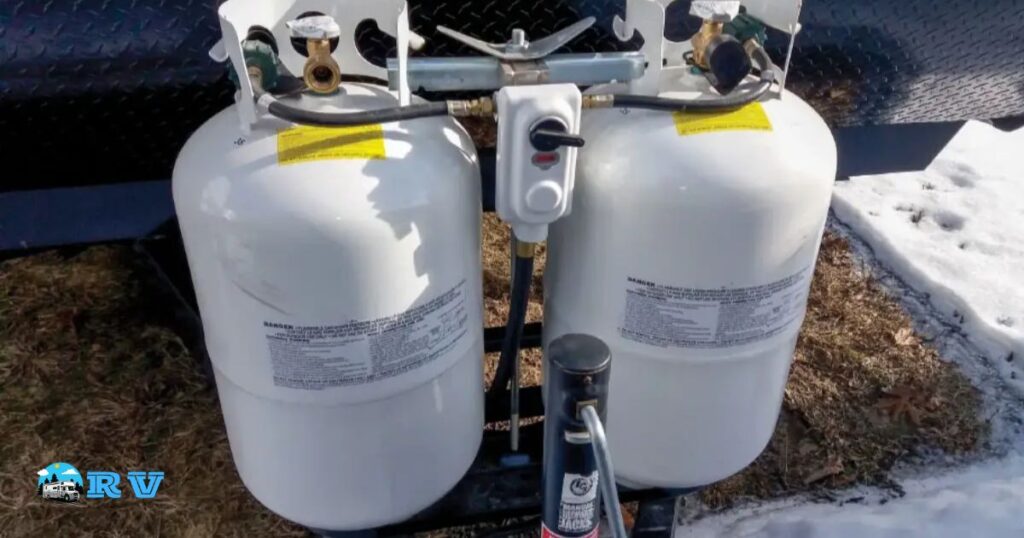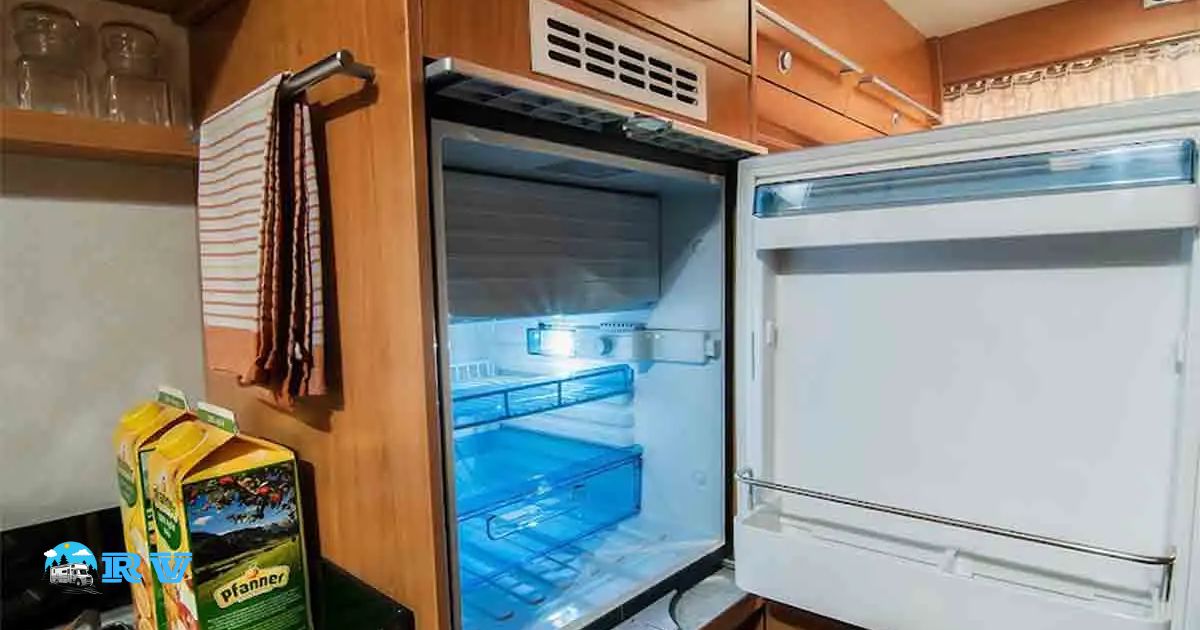Are you wondering how to switch your RV fridge from electric to propane? This process involves changing the source of power for your refrigerator in your recreational vehicle. In many cases, RV fridges can run on either electric or propane, giving you flexibility while travelling. Whether you’re looking to conserve electricity, need a backup power source, or want to boondock off the grid.
How do you make this switch? The process is quite straightforward and can be a lifesaver in various camping scenarios. In this guide, we’ll walk you through the simple steps of transitioning your RV fridge from electric to propane. Whether you’re a seasoned RVer or a beginner, you’ll find this knowledge essential for a smooth and enjoyable camping experience.
Switching your RV fridge from electric to propane can be particularly useful when you’re camping in remote areas without access to electrical hookups. It allows you to keep your food and beverages cold while conserving battery power for other essential RV functions. Additionally, switching to propane can be a cost-effective option when you have a propane supply readily available.
Reasons to Switch to Propane

Camping in an RV often involves various scenarios, from boondocking in remote locations to staying at full-hookup campgrounds. Knowing when and why to switch your RV fridge to propane is crucial for a smooth camping experience.
Off-Grid Camping and the Need for Alternative Power
Off-grid camping, also known as boondocking or dry camping, means you are camping without hookups, such as electricity. In such situations, your RV’s electrical power supply may be limited, making it essential to conserve energy. Switching your RV fridge to propane allows you to run it without draining your batteries, providing you with a reliable cooling solution even when you’re off the grid.
Conserving Electricity for Other RV Functions
Your RV relies on electricity to power various appliances, lighting, and entertainment systems. If you’re using electricity to run your fridge, it can consume a significant portion of your available power. By switching your fridge to propane, you free up electricity for other essential functions, ensuring you have enough power to run everything you need in your RV without overloading your electrical system.
Cost-Effective Cooling with Available Propane Supply
Propane is a common and cost-effective fuel source for RVs. If you have a propane supply readily available or if you’re planning an extended stay at a location where propane is easily accessible, using propane to power your fridge can be a budget-friendly option. It’s often more economical than relying solely on electricity, making it a practical choice for many RVers.
Preparing for the Switch
Before you can switch your RV fridge from electric to propane, there are a few essential steps and considerations to keep in mind.
Checking Propane Levels and Safety Measures
The first step is to ensure that you have an adequate propane supply in your RV, especially if you’re looking to RV water heater from propane to electric. Check the levels in your propane tank(s) to confirm that you have enough fuel to power your fridge..
Safety is paramount when dealing with propane, so it’s essential to follow proper safety measures and inspect your propane system for any leaks or issues. This includes checking for damaged hoses, connections, and making sure your propane detector is in good working order.
Verifying the Compatibility of Your RV Fridge
Not all RV fridges are equipped to switch between electric and propane modes. Check your fridge’s owner’s manual or consult the manufacturer’s specifications to verify if your fridge has this capability. It’s important to know what type of fridge you have before attempting the switch, as the process can vary depending on the model.
Understanding the Difference Between Automatic and Manual Switches
RV fridges typically come with two types of switches for changing the power source: automatic and manual. Automatic switches can sense the available power source and switch between electric and propane as needed. Manual switches, on the other hand, require you to physically select the desired power source. Understanding which type of switch your fridge has is crucial for a successful transition.
Guide to Switching
Now that you’re prepared and aware of the reasons to switch, let’s dive into the step-by-step process of switching your RV fridge from electric to propane.
Turning Off the Electric Power Source
Disconnect from Shore Power: If you’re currently connected to a power source at a campground (shore power), disconnect your RV from the electrical hookup. This step ensures that the fridge is no longer drawing power from the electrical source.
Locate the Fridge Control Panel: The control panel for your RV fridge can typically be found on the exterior of the fridge or inside the RV, depending on the fridge’s design. The panel will have options for selecting the power source.
Select Propane Mode: Switch the fridge to propane mode using the control panel. This is where the distinction between automatic and manual switches comes into play. If your fridge has an automatic switch, it will sense the absence of electricity and switch to propane on its own. For manual switches, you’ll need to manually select the propane mode.
Setting the RV Fridge to Propane Mode
Once you’ve turned off the electric power source, it’s time to set your RV fridge to propane mode.
Ensure Propane Supply: Verify that you have a sufficient propane supply in your RV’s propane tank(s). A propane gauge or monitoring system can help you keep track of the levels.
Check Fridge Readiness: Ensure the fridge is ready for propane operation. Some fridges have a safety lock or indicator that shows when they are ready to run on propane.
Select Propane on the Control Panel: If you have a manual switch, select the propane mode on the control panel. For automatic switches, this step may not be required, as the fridge will switch to propane on its own.
Testing the Propane Operation and Troubleshooting Tips
After making the switch, it’s important to test the propane operation and be aware of common issues that may arise.
Monitor Fridge Temperature: After a short period, check the fridge’s temperature to ensure it’s cooling as expected. It may take some time for the fridge to reach its optimal temperature on propane.
Troubleshooting Common Issues: If you encounter any RV fridge troubleshooting common issues, such as the fridge not cooling, check for common problems like improper propane supply, ventilation issues, or blockages in the propane lines. Refer to your fridge’s manual for troubleshooting tips.
Regularly Inspect Propane System: Periodically inspect your RV’s propane system to ensure it remains safe and leak-free. Address any propane-related issues promptly to maintain the efficiency and safety of your fridge.
Common RV Fridge Troubleshooting
| Issue | Possible Causes | Solutions |
| Fridge not cooling | Insufficient propane supply, ventilation issues, blockages in propane lines | Check propane supply, ensure proper ventilation, and inspect propane lines |
| Propane smell | Leaking propane, loose connections | Turn off propane, ventilate the area, and inspect for leaks and loose connections |
| Fridge not switching to propane | Automatic switch malfunction, wiring issues | Check the automatic switch and wiring, or manually select propane mode |
| Fridge not lighting | Air in the propane lines, dirty burner, faulty igniter | Purge air from propane lines, clean the burner, and check the igniter |
| Inconsistent cooling | Refrigerant issues, temperature settings | Check for refrigerant leaks, adjust temperature settings as needed |
Safety considerations to keep in mind
When dealing with propane in your RV, safety should always be a top priority. Here are some
Ventilation and Gas Leaks
Proper ventilation is essential when using propane, as it produces carbon monoxide, a colourless and odourless gas that can be harmful or even deadly if inhaled. Ensure that your RV is well-ventilated, especially when using propane appliances.
Install and maintain carbon monoxide detectors in your RV to alert you to any potential issues. If you smell propane, turn off the source, ventilate the area, and check for leaks.
Monitoring Propane Usage
Keep track of your propane usage to avoid running out of fuel unexpectedly. Propane tanks should be periodically inspected, and it’s a good practice to have a spare tank available, especially during extended trips. Understanding your RV’s propane consumption and having a reliable monitoring system can prevent inconvenient disruptions.
Ensuring a Secure and Stable Propane Supply
Inspect your propane system regularly, including the tank, hoses, connections, and regulators, to ensure everything is secure and in good condition. A stable propane supply is crucial for the efficient operation of your RV fridge and other propane-powered appliances. Additionally, consider investing in propane tank covers to protect your tanks from external elements and potential damage.
Tips and Best Practices
To make the most of your ability to switch your RV fridge from electric to propane, consider these tips and best practices.
Proper Maintenance for Your RV Fridge
Maintaining your RV fridge is essential for reliable performance. Regularly clean the fridge’s interior, coils, and vents to prevent dust and debris from impeding airflow. Keep the door seals in good condition to ensure an airtight seal, and defrost the freezer as needed to maintain optimal cooling efficiency.
Alternate Power Sources During Extended Stays
If you plan on staying in one location for an extended period, consider using a combination of power sources. For instance, switch to propane during the day when solar panels can charge your batteries, and switch back to electricity at night when you have surplus power. This approach maximises your energy resources and minimises the need for frequent propane refills.
Knowing When to Switch Back to Electric
There are times when switching back to electricity makes sense. If you have access to shore power at a campground or if you’re at a location with reliable electrical hookups, using electricity can be convenient. It’s also worth considering the weather conditions; in extreme cold, propane efficiency may decrease. Keep an eye on your power sources and choose the one that best suits your current situation.
FAQs
Can I switch my RV fridge to propane while driving?
Yes, you can switch to propane while driving, but it’s safer and more practical to use the vehicle’s battery or inverter to power the fridge during transit.
How long does it take for the RV fridge to cool on propane?
The time it takes for the fridge to cool on propane varies, but it typically ranges from 6 to 12 hours, so plan ahead before loading perishable items.
Is it safe to use propane for my RV fridge while sleeping?
Propane-powered RV fridges are designed to be safe for use during sleep. However, ensure proper ventilation and have a functioning carbon monoxide detector in your RV for added safety.
Can I switch between electric and propane frequently?
Yes, you can switch between electric and propane as needed. Most RV fridges are built to handle this transition without issues.
Do I need a professional to switch my RV fridge to propane?
Switching .our RV fridge to propane is a task that most RV owners can do themselves. However, it’s essential to follow safety guidelines and refer to your fridge’s manual for specific instructions.
Conclusion
In your RV journey, switching your fridge to propane is a must-know skill. It’s like having a secret tool for flexible and efficient camping. With the steps, safety tips, and tricks we’ve shared, you’re all set to make the switch with confidence. So, go ahead and enjoy your RV adventures, knowing that your food will stay fresh and your camping experience will be more versatile than ever.
Mastering this fridge switch is not just for the seasoned campers. Even if you’re new to RV life, you can make the most of it. So, as you hit the open road, keep this skill in your back pocket, and let your RV take you on unforgettable journeys, all while keeping your food cool and your spirits high.











